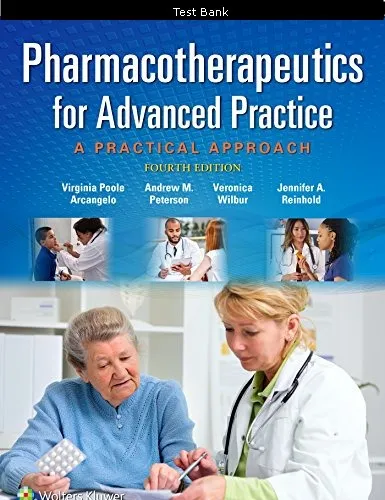Pharmacotherapeutics for Advanced Practice: A Practical Approach 4th Edition Test Bank
$55.00 Original price was: $55.00.$20.00Current price is: $20.00.
Digital item No Waiting Time Instant Download
Chapters: 32
Format: PDF
ISBN-13: 978-1496319968
ISBN-10: 9781496319968
Publisher: LWW
Authors: Virginia Poole Arcangelo, Andrew M.
Peterson PharmD, Veronica Wilbur, Jennifer A. Reinhold
Description
Pharmacotherapeutics for Advanced Practice: A Practical Approach 4th Edition Test Bank
Table of Contents
MULTIPLE CHOICE
A. The National Council of State Boards of Nursing
B. The U.S. Drug Enforcement Administration
C. The State Board of Nursing for each state
D. The State Board of Pharmacy
ANS: C PTS: 1
2. Physician Assistant (PA) prescriptive authority is regulated by:
A. The National Council of State Boards of Nursing
B. The U.S. Drug Enforcement Administration
C. The State Board of Nursing
D. The State Board of Medical Examiners
ANS: D PTS: 1
3. Clinical judgment in prescribing includes:
A. Factoring in the cost to the patient of the medication prescribed
B. Always prescribing the newest medication available for the disease process
C. Handing out drug samples to poor patients
D. Prescribing all generic medications to cut costs
ANS: A PTS: 1
4. Criteria for choosing an effective drug for a disorder include:
A. Asking the patient what drug they think would work best for them
B. Consulting nationally recognized guidelines for disease management
C. Prescribing medications that are available as samples before writing a prescription
D. Following U.S. Drug Enforcement Administration (DEA) guidelines for
prescribing
ANS: B PTS: 1
5. Nurse practitioner practice may thrive under health-care reform due to:
A. The demonstrated ability of nurse practitioners to control costs and improve patient
outcomes
B. The fact that nurse practitioners will be able to practice independently
C. The fact that nurse practitioners will have full reimbursement under health-care
reform
D. The ability to shift accountability for Medicaid to the state level
ANS: A PTS: 1
Chapter 2.Pharmacokinetic Basis of Therapeutics and Pharmacodynamic
MULTIPLE CHOICE
1. A patient’s nutritional intake and lab work reflects hypoalbuminemia. This is critical to
prescribing because:
A. Distribution of drugs to target tissue may be affected
B. The solubility of the drug will not match the site of absorption
C. There will be less free drug available to generate an effect
D. Drugs bound to albumin are readily excreted by the kidney
ANS: A PTS: 1
2. Drugs that have a significant first-pass effect:
A. Must be given by the enteral (oral) route only
B. Bypass the hepatic circulation
C. Are rapidly metabolized by the liver and may have little if any desired action
D. Are converted by the liver to more active and fat-soluble forms
ANS: C PTS: 1
3. The route of excretion of a volatile drug will likely be:
A. The kidneys
B. The lungs
C. The bile and feces
D. The skin
ANS: B PTS: 1
4. Medroxyprogesterone (Depo Provera) is prescribed IM to create a storage reservoir of the
drug. Storage reservoirs:
A. Assure that the drug will reach its intended target tissue
B. Are the reason for giving loading doses
C. Increase the length of time a drug is available and active
D. Are most common in collagen tissues
ANS: C PTS: 1
5. The NP chooses to give cephalexin every 8 hours based on knowledge of the drug’s:
A. Propensity to go to the target receptor
B. Biological half-life
C. Pharmacodynamics
D. Safety and side effects
ANS: B PTS: 1
6. Azithromycin dosing requires the first day’s dose be twice those of the other 4 days of the
prescription. This is considered a loading dose. A loading dose:
A. Rapidly achieves drug levels in the therapeutic range
B. Requires four to five half-lives to attain
C. Is influenced by renal function
D. Is directly related to the drug circulating to the target tissues
ANS: A PTS: 1
7. The point in time on the drug concentration curve that indicates the first sign of a therapeutic
effect is the:
A. Minimum adverse effect level
B. Peak of action
C. Onset of action
D. Therapeutic range
ANS: C PTS: 1
8. Phenytoin requires a trough level be drawn. Peak and trough levels are done:
A. When the drug has a wide therapeutic range
B. When the drug will be administered for a short time only
C. When there is a high correlation between the dose and saturation of receptor sites
D. To determine if a drug is in the therapeutic range
ANS: D PTS: 1
9. A laboratory result indicates the peak level for a drug is above the minimum toxic
concentration. This means that the:
A. Concentration will produce therapeutic effects
B. Concentration will produce an adverse response
C. Time between doses must be shortened
D. Duration of action of the drug is too long
ANS: B PTS: 1
10. Drugs that are receptor agonists may demonstrate what property?
A. Irreversible binding to the drug receptor site
B. Up-regulation with chronic use
C. Desensitization or down-regulation with continuous use
D. Inverse relationship between drug concentration and drug action
ANS: C PTS: 1
11. Drugs that are receptor antagonists, such as beta blockers, may cause:
A. Down-regulation of the drug receptor
B. An exaggerated response if abruptly discontinued
C. Partial blockade of the effects of agonist drugs
D. An exaggerated response to competitive drug agonists
ANS: B PTS: 1
12. Factors that affect gastric drug absorption include:
A. Liver enzyme activity
B. Protein-binding properties of the drug molecule
C. Lipid solubility of the drug
D. Ability to chew and swallow
ANS: C PTS: 1





Be the first to review “Pharmacotherapeutics for Advanced Practice: A Practical Approach 4th Edition Test Bank”